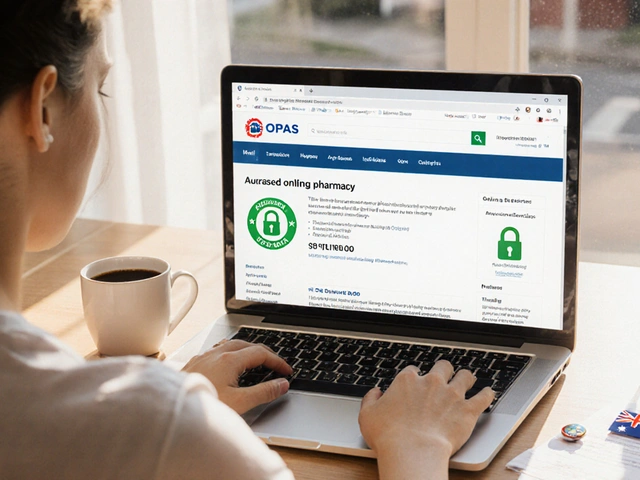If you take Esomeprazole for acid reflux or ulcers, you’ve probably wondered what else is out there. Maybe you’re dealing with side effects, price spikes, or want something that works better with your schedule. You’ve got options—plenty, actually—and each comes with its own perks and downers.
This isn’t just a list of hard-to-pronounce drug names. Here, you’ll get a straight-up breakdown: what each alternative does, who it’s good for, what to watch out for, and even a couple of real-world tips. Think of it as your shortcut to making a smarter, more comfortable switch.
You’ll see well-known meds like Omeprazole and Pantoprazole (think of them as Esomeprazole’s cousins), along with acid blockers for folks who want something milder or need to dodge some of the usual side effects. And for people with ulcers, there are even non-acid options on the menu. You’ll leave with clear, practical knowledge—so you and your doctor can actually have a useful conversation, not a guessing game.
- Omeprazole
- Pantoprazole
- Lansoprazole
- Rabeprazole
- Famotidine
- Ranitidine
- Cimetidine
- Sucralfate
- Misoprostol
- Antacids
- Conclusion
Omeprazole
If you’re hunting for an Esomeprazole alternative that works pretty much the same way, Omeprazole is the first place most people look. Both belong to the PPI (proton pump inhibitor) family, meaning they stop your stomach from making so much acid. The big news? Omeprazole was the first PPI to hit the market, so there’s a ton of experience behind its use. It’s often the cheaper, over-the-counter cousin to Esomeprazole, and pharmacies everywhere usually have it in stock.
Doctors reach for Omeprazole to treat GERD, stomach ulcers, and even for preventing ulcers in folks who have to take harsh painkillers like NSAIDs. You’ll find it under brand names like Prilosec and Losec. Most people take it as a pill—sometimes once a day, sometimes twice if things are really acting up.
Pros
- Widely available over the counter; affordable for most people.
- Backed by years of data—doctors know what to expect.
- Just as effective for acid reflux and heartburn as Esomeprazole in most cases.
- No crazy diets or frequent doses. Usually just swallow a pill before breakfast.
Cons
- Not always the answer for severe reflux or people who don’t respond well to PPIs.
- Can cause similar side effects as Esomeprazole: headaches, diarrhea, or sometimes even vitamin B12 or magnesium drops with long-term use.
- Some people notice the effect wears off if they use it every day for a long time.
A quick comparison for folks interested in the numbers:
| Drug | Typical Dose | Common Uses | OTC? |
|---|---|---|---|
| Omeprazole | 20-40 mg once daily | GERD, ulcers, acid suppression | Yes |
| Esomeprazole | 20-40 mg once daily | GERD, ulcers, acid suppression | Sometimes |
If you’re considering swapping from Esomeprazole to Omeprazole, chat with your doctor first—especially if you take other meds or have any liver issues. Both drugs can mess with how your body handles certain prescriptions like blood thinners. But for most people with straightforward heartburn or GERD, Omeprazole’s a natural move—and it just might save you some cash, too.
Pantoprazole
Pantoprazole is a popular alternative to Esomeprazole for treating acid reflux, GERD, and ulcers. You’ll often spot it with the brand name Protonix. It’s a proton pump inhibitor (PPI), so it works by turning down the acid pumps in your stomach—just like esomeprazole, but with a slightly different chemical setup. This can matter if you’ve had reactions to other PPIs, as some folks find pantoprazole a bit gentler on side effects.
Doctors love pantoprazole because you can take it with or without food, and you only need it once a day in most cases. That’s handy for folks who forget midday meds. There’s even an IV option, making it the go-to in hospitals if you can’t swallow pills. It’s also approved for both adults and kids (in slightly different doses), so it fits just about anyone who needs it.
One smart thing to know: Pantoprazole is less likely than some other PPIs to mess with common drugs, like blood thinners or certain anxiety meds. If you take medications that interact with your stomach acid level, that’s a big plus.
Check out the facts in this comparison:
| Drug | Standard Dose | With Food? | Main Uses |
|---|---|---|---|
| Pantoprazole | 40mg, once daily | Yes or No | GERD, erosive esophagitis, ulcers |
| Esomeprazole | 20-40mg, once daily | Usually empty stomach | GERD, ulcers, heartburn |
The World Gastroenterology Organisation points out,
"Pantoprazole is often preferred in situations where drug interaction risk is a concern and when intravenous therapy might be needed in acute care settings."
Pros
- Once-daily dosing (set and forget)
- Can be taken with or without food
- Lower risk of certain drug interactions
- IV form available for hospital use
- Usually well-tolerated, even for long-term use
Cons
- May cause headaches or diarrhea
- Rarely, can lower magnesium levels
- Long-term use might lead to vitamin B12 deficiency
- Like all PPIs, can increase risk of gut infections if used for months
If you want an easy shift from Esomeprazole or just a steady, no-fuss daily pill, pantoprazole is a practical pick. Always loop your doctor in on the switch—especially if you’re juggling other meds or have a tricky health situation.
Lansoprazole
If you’re searching for a proven backup to Esomeprazole alternatives for GERD and heartburn, Lansoprazole stands out. It’s a proton pump inhibitor, just like its famous cousin, but you’ll often see people switch between the two based on insurance, cost, or a hunch from their doctor that one might work better for their symptoms.
Lansoprazole is sold under brand names like Prevacid. It’s been around since the 1990s and is well-studied for both GERD treatment and ulcer prevention, especially in folks taking NSAIDs long-term (think ibuprofen and naproxen).
You can get it as a capsule, a tablet that dissolves on your tongue, or even as a sprinkle-friendly granule for people who can’t swallow pills. This makes Lansoprazole pretty handy if you’ve got trouble swallowing or need a dose on the go.
Pros
- Works fast—some feel relief within a day or two, though it works best if you stick with it for a while.
- Good for preventing ulcers if you’re on chronic NSAIDs (like arthritis or chronic pain patients).
- Comes in flexible forms: capsules, orally disintegrating tablets, granules for mixing with food or liquid.
- Can be used in both adults and kids—sometimes preferred in children due to the easy-to-take forms.
- Generic versions are cheap and widely available.
Cons
- Like other PPIs, it’s not meant for quick, one-shot relief (antacids are better for that).
- Can interact with some other meds—especially HIV drugs, certain blood thinners, or antifungal meds. Ask your pharmacist if you’re not sure.
- Low magnesium can happen after months of use. You’ll want to mention any muscle cramps or heart palpitations to your doc.
- Long-term use carries a risk of B12 deficiency, so older adults might need a blood test now and then.
- Some folks get headaches, belly pain, or diarrhea.
Fun fact: a clinical review found Lansoprazole works just as well as Omeprazole or Esomeprazole for most types of reflux—but the melting tablets are a nice bonus if you’re tired of swallowing pills.
| Form | Typical Dose | Available For Children? |
|---|---|---|
| Capsule | 15-30mg once daily | Yes |
| Orally Disintegrating Tablet | 15-30mg once daily | Yes |
| Granule Packet | 15-30mg once daily | Yes |
If your insurance balks at the cost of Esomeprazole, or you need a med that’s just a little easier on your gut, Lansoprazole could be your next step in acid reflux medication.
Rabeprazole
Rabeprazole is another member of the proton pump inhibitor (PPI) family—a close relative to Esomeprazole. Doctors prescribe it to tackle heartburn, GERD, and those nasty stomach ulcers that just won’t quit. It works by blocking the acid pumps in your stomach, so you get less burning and fewer flare-ups. Folks who don’t get full relief from other PPIs sometimes find Rabeprazole is just what they need.
If you want results fast, you’ll appreciate Rabeprazole because it starts kicking in a bit quicker compared to some other PPIs. That can make a big difference if you’re tired of waiting around for your meds to work. Plus, it’s often available in generic form, making it easier on your wallet when compared to branded Esomeprazole.
| Drug | Onset of Action | Available as Generic? |
|---|---|---|
| Rabeprazole | Fast (within 1 hour) | Yes |
| Esomeprazole | Moderate (1-2 hours) | Yes |
If you’re switching from Esomeprazole or another acid reducer and are worried about side effects, Rabeprazole could be worth a shot. Some people find it causes fewer headaches and stomach issues than similar meds, but of course, everyone reacts differently. Here’s what’s typically good and what needs caution.
Pros
- Usually works fast, so heartburn relief shows up quickly
- Effective for GERD, ulcers, and frequent acid reflux
- Available as a cheaper generic option
- Tends to use a once-daily dosing, keeping things simple
Cons
- Can still cause headaches, stomach pain, or diarrhea
- Long-term use (like other PPIs) may lower magnesium or vitamin B12
- Needs a prescription—no over-the-counter option in most places
- Not for instant relief—need to give it a day or two to build up full effect
If your reflux or ulcers don't seem to budge with your current meds or you just want to spend less, ask your doctor about Rabeprazole. Sometimes the tweak makes all the difference.
Famotidine
Famotidine—maybe you know it by the brand name Pepcid—is a go-to option if you’re looking for Esomeprazole alternatives for milder or occasional acid reflux. It falls into the group called H2 blockers, which means it works by stopping your stomach from making too much acid. That’s different from proton pump inhibitors (PPIs) like Esomeprazole, which actually turn off some of your stomach’s acid pumps. Famotidine isn’t as hardcore, but it can get the job done fast enough for most normal heartburn days.
Famotidine is especially popular because it kicks in quickly, sometimes within an hour, and you can grab it over-the-counter pretty much anywhere. Folks also like that it doesn’t have the same long list of drug interactions that PPIs can carry. It’s a solid backup if you’re worried about side effects or want something for those “just ate too much pizza” days.
Pros
- Starts working fast—often within 60 minutes
- Available over-the-counter or by prescription
- Short-term or long-term use possible
- Lower risk of long-term side effects seen with PPIs
- Less likely to mess with mineral absorption or gut bacteria
- Safe for people with mild kidney issues (with dose adjustment)
Cons
- May not work as well for severe GERD or ulcers
- Needs to be taken twice a day for steady symptom control
- Tolerance can build up if used every day for weeks
- Rare side effects include headache, dizziness, and muscle aches
- Not as protective for the stomach lining as some other options
If you’re wondering how it compares to Esomeprazole and friends, check out this quick look at typical dosing and relief time:
| Drug | Usual Dose | Onset Time | OTC? |
|---|---|---|---|
| Famotidine | 20–40 mg, 1–2x daily | 30–60 min | Yes |
| Esomeprazole | 20–40 mg, 1x daily | 1–4 days | Yes |
If you’re switching over or just trying out Famotidine, don’t expect it to nail down really stubborn reflux or big-time ulcers. But for steady, mild heartburn or as a backup on pizza night, it’s hard to beat. Just keep in mind that if you notice you’re reaching for it every day, talk to your doctor about your options—it might be time for a switch or a workup.

Ranitidine
Ranitidine used to be a top pick for dealing with acid reflux, GERD, and ulcer problems. It worked by shutting down some of the acid pumps in your stomach, making it pretty decent for people who didn’t get full relief from antacids or wanted something less powerful than PPIs like Esomeprazole. People liked how fast it kicked in and how you didn’t need to take it on an empty stomach.
But there’s something you really need to know: back in 2020, most ranitidine products got yanked from shelves. Why? Researchers found that some batches had NDMA, an impurity that can raise cancer risk if you take too much for too long. Because of this, Ranitidine is tough to find in pharmacies, especially in the US, Europe, and many other countries. If you see it on the market, double-check with your doctor or pharmacist since newer batches may have better safety checks or just might not be legal at all where you live.
If you’re thinking about ranitidine only because you want an H2 blocker (that’s the group of meds it belonged to), other options like famotidine or cimetidine haven’t had the same contamination warnings. Always smart to ask your prescriber or pharmacist about up-to-date advice before picking a replacement for Esomeprazole.
Pros
- Worked fast against heartburn and nighttime acid leaks
- Didn’t have to be taken on an empty stomach
- Well-tolerated for most people when in use
Cons
- Banned or discontinued in many countries due to NDMA impurity risk
- Long-term safety concerns for batches made before 2020
- Availability issues—other H2 blockers are just easier to get and safer now
| Year | Global Ranitidine Market Status |
|---|---|
| 2018 | OTC and prescription available worldwide |
| 2020 | Mass recalls and sales stopped |
| 2024 | Still largely unavailable, with rare new formulations in some regions |
If your main worry is GERD treatment or heartburn, ask about safer and more available drugs. Don’t pick old ranitidine from your bathroom shelf—it’s not worth the risk.
Cimetidine
Cimetidine is one of the old-school drugs folks use to tackle acid reflux, ulcers, and heartburn. It’s part of the H2 blocker family, which means it works by lowering how much acid your stomach makes. If you’ve tried strong meds like Esomeprazole alternatives and want something milder, Cimetidine is worth talking about with your doctor.
One interesting thing: Cimetidine has been around since the 1970s, so doctors know it inside out. While it’s not as powerful as modern proton pump inhibitors, it can still give solid relief for mild to moderate heartburn—and you don’t usually need a prescription for it. Lots of people grab it over the counter for a quick fix.
Pros
- Usually works in under an hour for heartburn or acid indigestion
- Can be used as needed—it’s flexible
- May cost less than PPIs like Esomeprazole or Omeprazole
- Available over the counter in most places
- Cuts nighttime acid production well (good for bedtime symptoms)
Cons
- Not as strong as proton pump inhibitors, so tough GERD cases may need more
- Can interact with lots of meds (blood thinners, certain antidepressants, heart meds)
- Older adults may be at risk for confusion or mental fog if using long-term
- Needs to be taken one or two times daily—not as simple as once-a-day PPIs
- Side effects: muscle aches, headache, sometimes diarrhea
Doctors sometimes avoid Cimetidine if you’re already taking a bunch of medications because of the drug interaction headache. If you only need something quick for mild acid reflux and you don’t have a huge list of other meds, though, it’s a reliable option. Just double-check with your doc or pharmacist if you’re adding it to your routine.
Sucralfate: A Barrier that Shields, Not Just Blocks Acid
Sucralfate isn’t your run-of-the-mill heartburn med—it’s more like a bandage for your insides. While Esomeprazole and its proton pump buddies mess with the stomach’s acid production, Sucralfate acts differently. This guy coats the lining where you have ulcers or raw spots, making a physical barrier between stomach acid and the sore tissue. So, instead of stopping acid, it’s keeping it away from places it shouldn’t go.
It’s especially useful for ulcer management and gives some relief for GERD (gastroesophageal reflux disease). Doctors like to pull it out when you really need your stomach lining to heal, or if other acid blockers just aren’t working for you. Oh, and pregnant patients get it quite a bit since it’s not easily absorbed into the blood and is considered pretty safe.
Pros
- Makes a protective barrier over ulcer spots—no fiddling with stomach pH.
- Minimal absorption by the body, so fewer systemic side effects.
- Seen as safe if you’re pregnant or sensitive to other GERD meds.
Cons
- You have to take it on an empty stomach or it just doesn’t work right.
- Dosing can be a hassle: usually 4 times a day, plus extra work to avoid other meds at the same time.
- Constipation is common, especially if you’re prone to it or not drinking enough water.
If you’re juggling a full pill schedule or taking lots of other meds, Sucralfate can be a pain because it needs a clean patch of stomach to do its job—so you have to space it far from many other drugs. For people who don’t get along with acid reflux medication that changes acid levels, Sucralfate can be a solid break from that routine.
| Common Use | Dosing Schedule | Pregnancy Safety |
|---|---|---|
| Ulcers, GERD | 4x daily on empty stomach | Considered safe |
Misoprostol
Misoprostol is one of those meds that doesn’t usually grab the spotlight for heartburn or GERD, but it has a unique way of helping people protect their stomach lining. It’s a synthetic version of a natural prostaglandin, which means it helps boost your body’s own defenses against stomach acid. Doctors often reach for Misoprostol when someone’s at high risk of getting ulcers, especially from taking a lot of NSAIDs (like ibuprofen or naproxen).
Here’s how it works: Misoprostol helps the stomach make more mucus and bicarbonate, acting like an extra thick coat to keep acid from eating up your gut. Unlike traditional acid reflux medications such as Esomeprazole, Misoprostol doesn’t just block acid—it builds a barrier. For some folks, this offers a much-needed layer of protection, especially if they can’t quit NSAIDs for chronic pain.
Pros
- Reduces the risk of NSAID-related ulcers by up to 80% in studies.
- Protects the whole stomach and the duodenum (not just one area).
- Works differently than acid blockers, so it's good for people who need extra protection.
Cons
- Common side effect: diarrhea (up to 30%, based on studies—yep, it’s that common).
- Not safe during pregnancy since it can cause miscarriage or early labor.
- Needs to be taken multiple times a day for best protection.
- Can cause cramping and other GI upset, especially at the start.
If you’re considering Misoprostol as a GERD treatment or for ulcer prevention, talk about your current meds and health situation with your doc. The diarrhea risk isn’t just a rumor—it can be a dealbreaker for people with sensitive guts. Still, for someone stuck on NSAIDs, it could be the best option on this Esomeprazole alternatives list.
| Use | How Often | Main Risk |
|---|---|---|
| Ulcer protection from NSAIDs | 4 times a day | Diarrhea, pregnancy risks |
So, Misoprostol isn’t your typical acid reflux pill, but it covers bases that PPIs can’t. It’s smart to keep it in mind if you need that extra stomach lining protection, especially if other drugs haven’t done the trick.
Antacids
Antacids are the go-to fix for acid reflux, heartburn, or that burning in your chest after spicy food. These are the chalky chewables or liquids you grab from the store—think brands like Tums, Rolaids, or Mylanta. They work right away because they neutralize stomach acid on contact, no waiting around for hours.
Here’s the thing: Antacids don’t stop acid from forming like Esomeprazole or other PPIs. They just mop up what’s already there. If you just get heartburn once in a while, they’re perfect. If you’re dealing with frequent GERD, you’ll probably need something stronger for the long haul.
- Calcium carbonate (Tums): Good for a quick fix, but you don’t want to overdo it—too much can mess with your calcium levels.
- Magnesium hydroxide (Milk of Magnesia): Works fast and great for loosening things up if you’re also struggling with constipation.
- Aluminum hydroxide: Sometimes mixed with magnesium to lower side effects. Too much can cause constipation, though.
All antacids act super fast, usually bringing relief within minutes. That’s their biggest selling point: instant comfort when you need it.
Pros
- Work almost immediately—great for sudden acid reflux or heartburn
- No prescription required, easy to find in any pharmacy
- Flexible—you take them only when needed
- Can be used alongside other meds safely (but check if you're on lots of prescriptions)
Cons
- Relief is short-term—doesn’t fix root problems like chronic GERD
- Overuse can mess with electrolytes, especially calcium or magnesium
- Some types can cause constipation or diarrhea if you use them a lot
- Can interfere with how your body absorbs certain medications (like some antibiotics and iron pills)
If you’re using antacids all the time, it’s a sign you might need a stronger GERD treatment. But if spicy pizza is your only trigger and it’s just once in a blue moon, these little tablets are a total lifesaver.
| Type | Onset Time | Common Side Effect |
|---|---|---|
| Tums (calcium carbonate) | 1-5 min | Constipation (rarely) |
| Milk of Magnesia | 1-5 min | Diarrhea |
| Mylanta/Rolaids | 1-5 min | Constipation or diarrhea |
Bottom line: antacids beat waiting on prescription meds when you need comfort now, but don’t expect them to cure anything long-term. Mix them up with other heartburn fixes only if your doctor’s cool with it, especially if you already take a bunch of other stuff.

Conclusion
Finding the right option for heartburn, GERD, or ulcers really comes down to your symptoms, your health history, and what you want out of a treatment. Swapping out Esomeprazole doesn’t mean starting from scratch—options like Omeprazole or Pantoprazole work in almost the same way, so you probably won’t notice much difference in effect or how fast you feel better. But if you struggle with side effects from PPIs or want something with a different risk profile, H2 blockers like Famotidine or Cimetidine are worth considering. They don’t last as long, but some people get less trouble with headaches or gut issues.
For people who can’t—or shouldn’t—take acid reducers (think: pregnancy, allergies, long-term risks), something like Sucralfate is surprisingly helpful. It doesn’t change your stomach’s pH, so it’s a good fit for people who just need protection for a sore stomach or ulcers. Antacids are still the go-to for fast relief but aren’t built for long-term use. Keep in mind: Ranitidine was pulled from shelves over safety concerns, so it’s not a first pick anymore in most countries.
Always check with your doctor or a real-life pharmacist before switching up your meds. Some drugs play better with other prescriptions and health conditions than others. Plus, insurance might cover one but not the next—nobody wants an extra bill in the mail!
| Alternative | How It Works | Main Pros | Common Cons |
|---|---|---|---|
| Omeprazole | PPI (reduces acid) | Similar to Esomeprazole, affordable | May cause headaches, takes a day or two to kick in |
| Pantoprazole | PPI (reduces acid) | Usually well-tolerated | Can lower magnesium long-term |
| Lansoprazole | PPI (reduces acid) | Fast-acting, now available OTC | Interacts with some meds |
| Rabeprazole | PPI (reduces acid) | Fewer drug interactions | Costlier in some places |
| Famotidine | H2 blocker | Short-acting, fewer side effects | Doesn’t work as long as PPIs |
| Ranitidine | H2 blocker | Used to be go-to, but recalled in most markets | Safety concerns, mostly unavailable |
| Cimetidine | H2 blocker | Older, still cheap | Interferes with many other meds |
| Sucralfate | Mucosal protectant | Safe for ulcers, safe in pregnancy | Needs empty stomach, constipation risk |
| Misoprostol | Prostaglandin analog | Protects lining, great for NSAID ulcers | Diarrhea, not for use in pregnancy |
| Antacids | Neutralize acid on contact | Fast relief | Short-lasting, high doses can upset gut |
If you’re struggling with GERD treatment or want a solid Esomeprazole alternative, bring this info to your next appointment. Sometimes just switching to a different med can make a world of difference in how you feel day to day.





Comments (16)